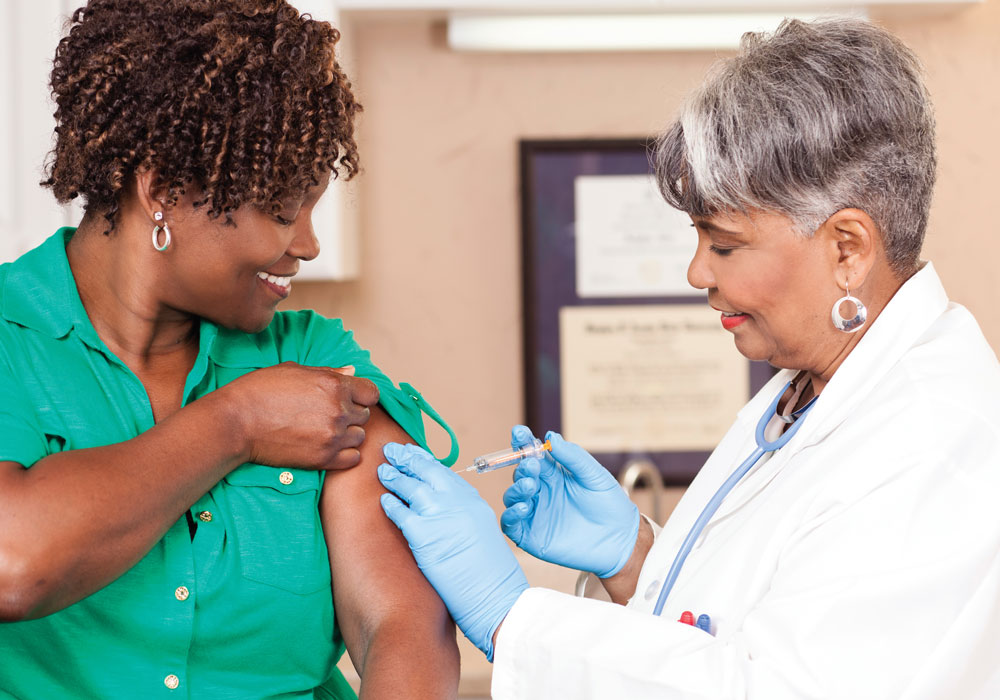Last updated: January 13, 2022
Nearly 60 million people in the United States and almost 200 million around the world have received the COVID-19 coronavirus vaccine as of mid-February 2021, and the numbers will continue to grow as more doses come to market and other manufacturers’ versions receive emergency use authorizations. As more people get vaccinated, some of the expected side effects are being observed in clinical practice and have implications for cancer care.
Vaccines and Lymphadenopathy
Axillary adenopathy, or swelling of the lymph nodes in the axilla, can be found on physical exam or during breast imaging, potentially prompting additional assessment and work-up for a potential breast cancer diagnosis because it can indicate more advanced, metastatic disease. Because unilateral axillary adenopathy is a potential side effect with COVID-19 vaccination, providers need to be aware of the concern for patients receiving routine mammograms after their vaccinations.
The side effect has been reported with other vaccines such as BCG and influenza but is considered rather rare. Findings from both the Moderna and Pfizer COVID-19 vaccine trials have reported incidence of axillary adenopathy as a potential side effect following vaccination. Axillary adenopathy was reported as an adverse event in the Moderna vaccine trials in 11.6% and 16% of patients after the first and second vaccine doses, respectively, compared to 5% and 4.3% receiving placebo. The reported incidence was lower in the Pfizer COVID-19 vaccine trials, but it may be higher in practice because lymphadenopathy was reported only as an unsolicited adverse event.
In clinical trials, lymphadenopathy generally presented in the two to four days following COVID-19 vaccination and lasted an average of one to two days. However, since the vaccines have become widely dispersed to the public, studies have shown the median onset after first and second doses of a COVID-19 vaccine is 12 and 5 days, respectively. In addition, recent evidence identified the duration to be anywhere from a few days to six weeks postvaccination.
Lymphadenopathy has been reported following the third booster dose of the COVID-19 vaccine as well Previous reports have cited it occurring more frequently and with higher intensity in positron-emission tomography or computed tomography scans after second doses of the vaccine, and healthcare providers should consider it up to 60 days following any of the vaccine doses.
Symptoms may include swelling of lymph nodes in both the arm and neck, which may or may not be tender to palpation.
What Oncology Nurses Need to Know
In response to the increased risk for axillary adenopathy, the Society for Breast Imaging (SBI) issued recommendations for healthcare providers:
-
Add COVID-19 vaccination status to intake forms for patients presenting for breast imaging, including when the vaccine was administered and in which arm (right versus left).
-
When possible, consider scheduling breast screening exams prior to the first dose of the COVID-19 vaccine or four to six weeks after the second dose.
-
If a patient has unilateral axillary adenopathy on screening exams, additional assessment and diagnostic work-up (e.g., additional mammogram views, ultrasound) should follow current imaging grading and guidelines.
-
Short-term follow-up (4–12 weeks following the second dose of vaccine) in patients who received the COVID-19 vaccine and have unilateral axillary adenopathy should be considered. If adenopathy persists after the follow-up period, lymph node sampling may be indicated.
-
Provide patient education that lymph node swelling can occur temporarily with vaccines because it can be an indicator that the body is responding appropriately and making antibodies.
Nurses should be aware of the potential for axillary adenopathy, timing of onset, and recommendation for screening exams. Providing patient support and education on the current recommendations is also important to alleviate any anxiety and concern if lymph node swelling is found during physical exams or imaging studies. Patients should discuss with their providers before scheduling any mammograms, particularly if they had delayed until after vaccination.






